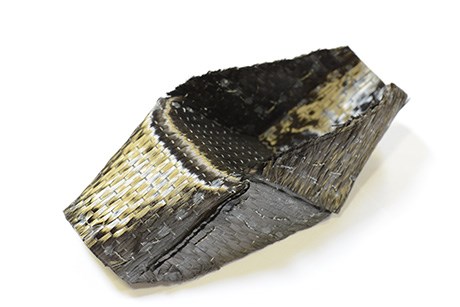Seriforge: A new paradigm for composite preforms
Silicon Valley startup aims to produce complex 3D carbon fiber preforms with z-axis reinforcement at mass production scale using automated processing lines.

Source: Seriforge
is new to the composites industry, but its principals have a long history in solving complex 3D problems using digital technology and mechatronics (combination of electronics with mechanical engineering and computer engineering). Their goal: nothing less than to revolutionize composite parts manufacturing. Their method: use digital technology and control systems engineering to solve the age-old problem of how to make complex composite parts quickly.
How quickly? “Our focus is on industrial-scale production,” says Seriforge VP of business development, Marco Zvanik, “long-term, we’re targeting 10,000-20,000 parts/month using a single automated processing line.” But this is about preforms, right? To produce parts, there would still be additional operations required, like resin transfer molding (RTM)? Yes, Seriforge is targeting preforms, but in future iterations it will also be able to cure these preforms. But that’s looking forward. Let’s look at what the company has achieved so far.
The original idea was to create complex fiber preforms directly from CAD models, including z-axis reinforcement where needed. This would eliminate the time-consuming and error-prone manual operations of cutting, splicing and stacking. Stitching is used to bind the preform layers together, which increases delamination and impact resistance, but unlike Z-pinning (see 3rd & 4th paragraphs, “3-D woven reinforcements update”), Seriforge uses a continuous carbon fiber stitch that does not have loops or knots, which normally disturb load-bearing fibers. “There is also no disruption in the preform surface,” says Zvanik.
The details of Seriforge’s fully automated process are proprietary, but the basic paradigm shift is to decouple 3D textile preforming from a loom and broadgoods mindset. Instead, envision a 3D printing machine where multiple different 2D materials — e.g. woven or uni fabrics, veils, plastics, films — are cut, oriented and stacked. As they are being stacked they may be stitched to adjacent layers or all the way through the preform, depending upon the digital design. A wide variety of fibers can be used for the preforms, but carbon is currently the most popular. Carbon fiber is also used for the stitch yarn, but other yarn types may be used as well. Seriforge's process can also stitch through core materials such as foam.
The company has the capability to take a CAD model of a part and generate a flat, “unfolded” preform with fiber placement optimized for load, and then fold that into its 3D net-shape form. If the part comprises developable surfaces, then no darts or cuts are needed. If not, then Seriforge’s software can program these accordingly to achieve the final part shape and load requirements.
Zvanik says the process does not require separate forming tools, but instead uses an ingenious system of part-specific cartridges with automated folding and forming built-in. “We want to provide a solution not just for large OEMs and Tier 1 suppliers that want to make 100,000 plus parts per year,” Zvanik explains, “but also for companies that want to make 100 or 1,000 complex parts and cannot afford the cost of preform tooling.”
Seriforge will sell preforms and parts, not machines. “Our process won’t do prepreg and it doesn’t compete well with prepreg for thin-walled tubes and panels,” says Zvanik, “but we can offer dramatic cycle time and cost savings as preform size, thickness and complexity increases.” He notes the company is already working with 10-12 different manufacturers, targeting aerospace, automotive, oil & gas and recreational products. “We have a pipeline of applications in development ranging from near-term to long-term commercialization,” he explains.
Related Content
Toray rCF from Boeing 787 is incorporated into ultra-light laptops
Torayca-based aerospace components have successfully been repurposed into the Lenovo ThinkPad X1 Carbon Gen 12, highlighting the ongoing application of recycled composites.
Read MoreComposite innovations feature automotive, water sports, UAV and consumer project versatility
JEC World 2025: Precision, performance and reliability are at the core of Cobra International’s display, involving a front end, portfolio of water sports applications, a fixed wing drone and more.
Read MoreComposites end markets: Electronics (2025)
Electronic and smart device innovations achieved through the use of advanced materials ranging from thermoplastic composites to biomaterials emphasize high-volume production and sustainability.
Read MoreCarbon Mobile carbon fiber powers handheld gaming platform
HyRECM technology effectively stabilizes carbon fiber’s electrical and antenna properties, enabling development of next-gen electronics, such as the Snapdragon G3x Gen 2.
Read MoreRead Next
Ultrasonic welding for in-space manufacturing of CFRTP
Agile Ultrasonics and NASA trial robotic-compatible carbon fiber-reinforced thermoplastic ultrasonic welding technology for space structures.
Read MoreScaling up, optimizing the flax fiber composite camper
Greenlander’s Sherpa RV cab, which is largely constructed from flax fiber/bio-epoxy sandwich panels, nears commercial production readiness and next-generation scale-up.
Read MoreCutting 100 pounds, certification time for the X-59 nose cone
Swift Engineering used HyperX software to remove 100 pounds from 38-foot graphite/epoxy cored nose cone for X-59 supersonic aircraft.
Read More












